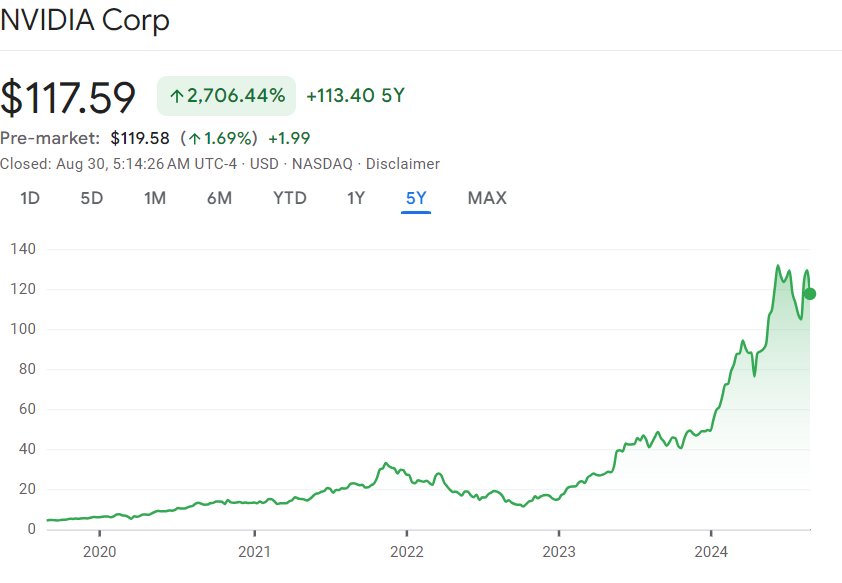As someone who is keen to break down the barriers of investing for beginners, in this article we are going to talk about the recent highly talked about Ndivia earnings and break down the jargon into real terms.
The earnings report was pretty good and they are clearly the rulers of AI, so that happened with the stock price of Nvidia when the earnings were released the other day? Lets look beyond the jargon and numbers to put things into context a little.
Is now a good time to invest in Nvidia? It´s a question I see coming up all the time and likewise, in forums and chat rooms I see endless retail investors (retail investor means people like you and me) who have very high hopes in the short term and who are very uncertain and nervous about investing in Nvidia or what to do with their investment that´s already in place.
Earnings Overview
Nvidia’s second-quarter earnings exceeded expectations, reporting an adjusted EPS and revenue that surpassed analyst forecasts. The company projected $32.5 billion in revenue for the upcoming quarter, which was above the consensus estimate of $31.7 billion. This performance was largely attributed to the robust demand for its AI-related products, particularly in the data centre segment, which saw a year-over-year revenue increase of over 150%. However, despite these positive results, Nvidia’s stock fell approximately 8% in after-hours trading following the earnings announcement. Analysts noted that while the results were strong, the guidance for the third quarter raised concerns about the sustainability of growth, particularly given the high expectations set in the previous fiscal year. The stock’s decline was also influenced by broader market trends, as other semiconductor stocks experienced similar downturns.
Concerns and Challenges
- Sustainability of Growth: Analysts expressed scepticism about Nvidia’s ability to replicate the explosive growth seen in the previous fiscal year, with projections indicating a potential revenue decline of 16% year-over-year. Concerns were raised about the company’s heavy reliance on a small number of clients, including major tech giants like Microsoft and Amazon, which contribute significantly to its revenue.
- Market Dependency: Nvidia’s exposure to geopolitical tensions, particularly regarding its inability to export certain products to China, poses a risk to its growth. The upcoming Blackwell chips, which are expected to enhance AI processing capabilities, may also face export restrictions, further complicating the company’s market strategy.
- High Valuation Risks: The overall high valuation of Nvidia’s stock raises questions about whether it can maintain investor confidence in a potentially “risk-off” market environment. The company’s stock-based compensation and the recent trend of institutional investors becoming more cautious could lead to increased volatility.
Concerns and Challenges
- Sustainability of Growth: Analysts expressed skepticism about Nvidia’s ability to replicate the explosive growth seen in the previous fiscal year, with projections indicating a potential revenue decline of 16% year-over-year. Concerns were raised about the company’s heavy reliance on a small number of clients, including major tech giants like Microsoft and Amazon, which contribute significantly to its revenue.
- Market Dependency: Nvidia’s exposure to geopolitical tensions, particularly regarding its inability to export certain products to China, poses a risk to its growth. The upcoming Blackwell chips, which are expected to enhance AI processing capabilities, may also face export restrictions, further complicating the company’s market strategy.
- High Valuation Risks: The overall high valuation of Nvidia’s stock raises questions about whether it can maintain investor confidence in a potentially “risk-off” market environment. The company’s stock-based compensation and the recent trend of institutional investors becoming more cautious could lead to increased volatility.
New Developments and Analyst Views
Nvidia’s recent partnership with CrowdStrike to enhance cybersecurity for AI applications has been viewed positively, as it indicates the company’s commitment to integrating its technology with emerging trends in AI safety and security. This collaboration could open new revenue streams and enhance Nvidia’s appeal in the enterprise market. Overall, while Nvidia’s earnings report showcased strong performance and continued demand for its AI products, the market’s reaction reflects underlying concerns about the sustainability of this growth and the challenges posed by external factors. Analysts remain divided, with some expressing optimism about the company’s future prospects, while others caution about potential headwinds that could impact its stock performance in the coming quarters.
In plain English?
Nvidia is by no means a new name on the block. This company has been around for years, and going back to my days in the tech sector (and we are talking over 20 years ago), Nvidia was, even back then, the absolute name to go for when computer buyers were seeking the best graphics card for their high powered gaming machines.
Their track record is strong and this reputation, combined with the huge progress that have made in AI has driven their stocks through the roof. When I talk about overall returns, we would expect something like the S&P 500 (the 500 biggest companies in the USA) to grow, on average – taking into account the good and bad years, by around 8-10% per year. This is considered very healthy. Now lets take a look at how Nvidia have done:

The image above shows their growth over the last 5 years. You can see that most of that has been achieved since last year. This has been mostly due to their advances within the AI area and their powerful chips that up until now, pretty much nobody can beat. The chart above shows why so many investors have jumped on the bandwagon with this stock over recent months,
Business valuations are complicated things and every economist or analyst will have their own way to draw conclusions but a big part of how much a business is worth is the predicted numbers for the future. This speculative pricing means that investors buy (and buy big) with enormous confidence in future returns and for anyone who invested in Nvidia 5 years ago (or even a year or two ago)is now sitting on a little goldmine.
Business report frequently their financial information. This shows many metrics which all mean different things and some are subtle but very important. But, the core nuts and bolts are:
- How much revenue has the business generated
- How much margin do they have
- How much their bottom line profits are
The other thing that businesses present each year are projections for the coming year. These are not just works of guessing (although that´s another point for another time) but they are the statement of what they will do and how they will perform the year after. Then, when they release earnings reports the real data how how they did is compared to the data that they said they would do. So in an earnings release like we saw with Nvidia the other day, although there are many many factors that analysts look at, the core nuts and bolts are:
- Did they achieve what they said they would for this period?
- Are they on track to achieve what they have previously said they will in the next period?
- What are the “guidance” (forecasts) for the next period
- What goes in their favour
- What challenges may they (or do they) face
- How likely are they to meet those challenges and deliver
In a “normal” business, and I use the word normal very loosely, but in a run of the mill industry, investors want to see stable growth, realistic (albeit exciting) predictions and the numbers coming more or less where they expect. The problem with Nvidia (and others in tech) is that their reputation as sector leaders has caused them not only to deliver but to blast the predictions into the air and thrash them with prenominal growth that never seems to stop.
The consequence of this is that more investors put in their hard earned cash, waiting to see just how much they can get in a short period and with that, the pressure is on the company to not just meet their targets but to soar above them and predict even more growth. As long as they keep doing that and it all stacks up then the price will rocket which has been the case with Nvidia in the recent years.
So, when we are talking about a company that is in a volatile sector, has grown at such a tremendous rate and investors are hungry for more, it means that meeting targets is no longer good enough. The stock is valued on the future values not on what it would be worth in real terms right now.
Would I buy Nvidia stock now?
A lot have asked me and for the purpose of transparency I am happy to tell you where I am. This is not in any way advice and you should base your decision on your own strategy, portfolio and risk tollerance.
I have actually never held much in Nvidia, it is in my portfolio but I really like to diversify. With the earnings I chose a time to reduce and take the profit from one of my investments (the one in Euros because I wanted to leave the USD holding in place so I can be more responsive in terms of decision making). With the dip I have entered again in a very small way. My target price to go in seriously was 115$ and it didn´t quite dip that far so I took a very small position which I will now hold and leave (unless something terrible happens).
Lets remember that Nvidia is an enormous business, the scale of it is beyond the imagination of most of us and its a very healthy business with a strong client base and an established fantastic track record. There´s a lot going on the world of AI, competitors are looking to take some of the market share and things are evolving so I think its unrealistic to see Nvidia increase in value at the rate that is has been recently but thats not a bad thing, its a reflection of how business works. So yes, I believe in the business for the time being and I am not too worried about my money certainly for the next few months but I think growth will slow down and the coming year or so may see others close at least some of the gap between Nvidia and other companies.





